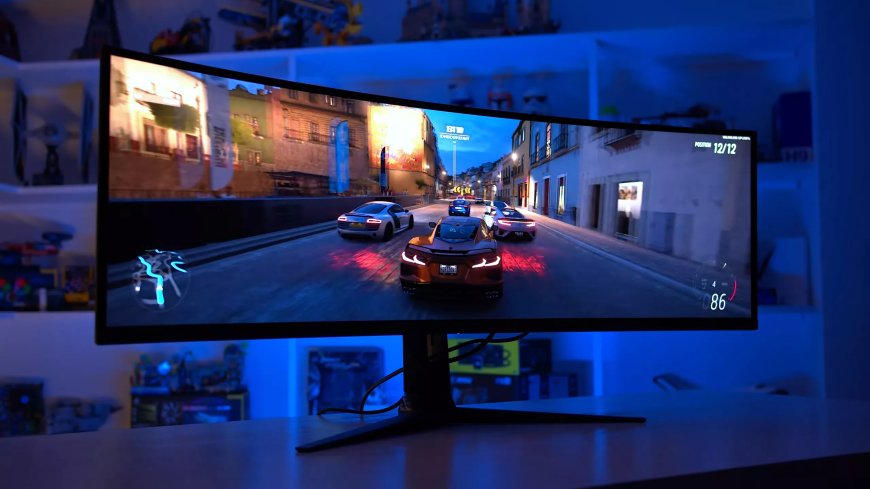Asus ROG Swift OLED PG49WCD 49" Monitor
The Asus ROG Swift PG49WCD is a new entrant in the super-ultrawide OLED monitor market, featuring a second-generation QD-OLED panel from Samsung. This 49-inch display, similar to Samsung's Odyssey OLED G9, is targeted at gamers seeking a premium experience with a large screen size and advanced display technology.

Design and Specifications
Physical Dimensions and Aspect Ratio
The PG49WCD's 49-inch screen with a 32:9 aspect ratio provides an immersive experience, similar to having two 27-inch 2560 x 1440 monitors side by side. The monitor's large width, about 1.2 meters, is balanced with a height comparable to standard 27-inch displays. Its 1800R curvature enhances the immersive experience, particularly for gaming and productivity.
Also check Corsair Hydro X Series XR5 360 NEO Water Cooling Radiator
Ultrawide Gaming Experience
As an ultrawide monitor, the PG49WCD goes beyond traditional 21:9 monitors, offering an even more immersive field of view. However, its 32:9 aspect ratio may not be universally supported by all games, potentially requiring modifications for optimal compatibility.
Refresh Rate and Comparison with Competitors
The monitor’s refresh rate is capped at 144Hz, a notable difference from Samsung's G9 and MSI's upcoming 491C, both of which can reach 240Hz using the same panel. This choice by Asus is particularly interesting considering the monitor’s positioning as a premium gaming display.
Asus's Aesthetic and Build Quality
The PG49WCD follows the design language of other Asus ROG monitors, featuring a thin panel section and a central rear box housing components. It sports a matte grey plastic exterior with good build quality, an RGB-lit ROG logo, and a stand that provides height, swivel, and tilt adjustments.
Connectivity and Input Options
Ports and Input Support
The monitor offers a range of connectivity options including DisplayPort 1.4 with DSC, HDMI 2.1, USB-C with DP-Alt mode and 90W power delivery, a three-port USB hub, and optical audio out. It also includes a built-in KVM switch for multi-input use.
HDMI 2.1 and Aspect Ratio Considerations
With full bandwidth HDMI 2.1 support, the monitor accommodates various input modes like 1440p at 144Hz and 4K at 120Hz. However, using the monitor in a 16:9 aspect ratio for extended periods might cause uneven wear due to OLED’s inherent burn-in risk.
On-Screen Display and Features
OSD and Utility Features
The PG49WCD's OSD, controlled by a directional toggle, offers a comprehensive feature set including crosshairs, FPS counter, sniper mode, shadow boosting, and extensive color controls. It also includes OLED care features like screen shifting, auto-dimming, and pixel refresh modes, with the option to disable DSC.
Screen Coating, Subpixel Layout, and Burn-In Considerations
Improvements in QD-OLED Technology
Samsung's second-generation QD-OLED panels show improvements in subpixel structure, enhancing text clarity compared to first-generation panels. While there's still some fringing effect, it's less noticeable than in older models. The second-gen QD-OLED is also preferred for text-heavy applications over WOLED panels.
User Experience with Text and Content
The review notes that while the text clarity is not as sharp as RGB-stripe subpixel LCDs, it is adequate for occasional desktop use and does not detract from content consumption experiences like gaming.
Conclusion: The Asus ROG Swift OLED PG49WCD in the Gaming Monitor Market
Overall Impressions and Positioning
The Asus ROG Swift OLED PG49WCD stands out as a high-end gaming monitor, offering an expansive ultrawide QD-OLED screen with immersive curvature. Its blend of cutting-edge technology, large screen size, and gamer-focused features make it a compelling choice for enthusiasts.
Considerations for Potential Buyers
Prospective buyers should consider the monitor’s aspect ratio support for their preferred games, the difference in refresh rates compared to similar models, and the potential for OLED burn-in with certain usage patterns. The PG49WCD represents a significant step in ultrawide gaming displays, combining Asus's design expertise with advanced OLED technology.


































